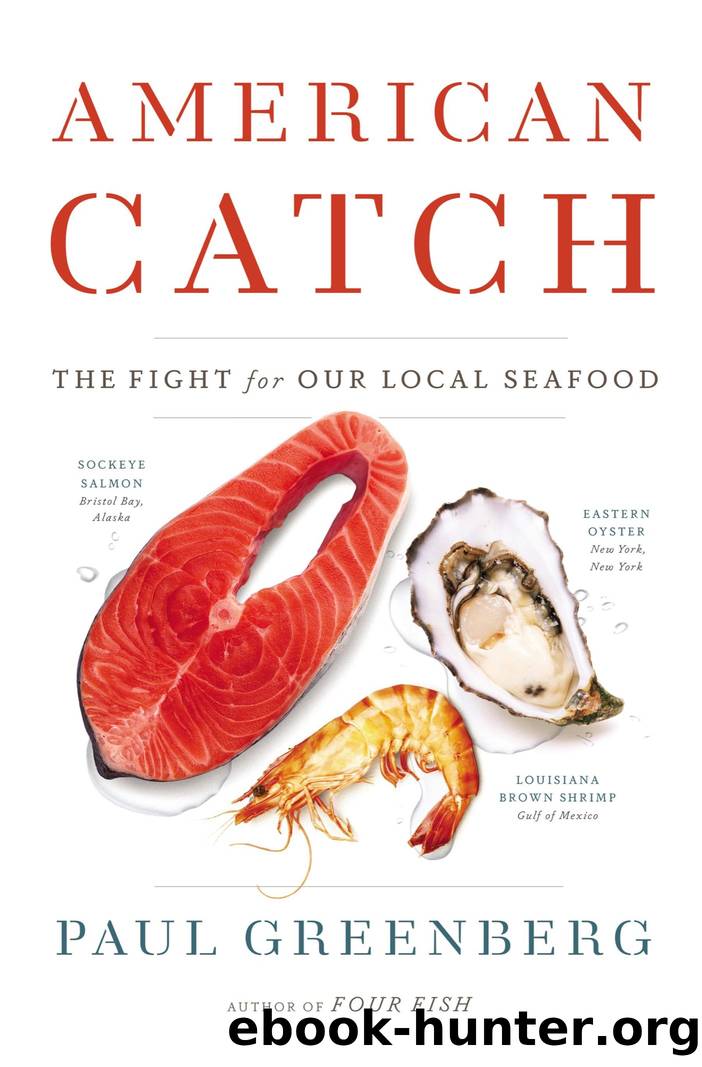American Catch : The Fight for Our Local Seafood (9780698163812) by Greenberg Paul

Author:Greenberg, Paul
Language: eng
Format: epub
Publisher: Penguin USA
Published: 2014-05-22T00:00:00+00:00
The Dawn and Dusk of Salmon
The oldest salmon-like creature we have found to date appeared about forty to fifty million years ago in the Eocene epoch. The Eocene, whose name comes from the Greek eos, âdawn,â was quite literally the dawn of many of the preconditions that allowed human beings to exist. At the outset of the Eocene, carbon dioxide in the atmosphere spiked at levels well over 1,000 parts per million (our current CO2 concentrations are about 400 parts per million). No large mammals walked the earth then and the poles were at times downright balmy. By the end of the epoch, global temperatures would begin to cool and approach temperate levels, allowing for the rise of the precursors to our modern cultivated crops. The oceansâ carboniferous bivalves and plankton would surge and sequester carbon at a fantastic rate, bringing carbon in the atmosphere down to around 700 parts per million. Swarms of krill would begin to form around aggregations of plankton in the cooling waters of what would become the Bering Sea. The poles would take on their present form, cold and icy, and a regulating mechanism for the modern climate. It was right in the middle of this transition that salmon began to emerge.
The several different Pacific salmon species evolved life cycles that brought them to a stretch of ocean from the Bering Sea to the California coast, where plankton and krill converge. Sockeye salmon are particularly dependent on krill. And by feeding on krill, sockeye salmon acquire a plankton-synthesized compound called astaxanthin, a red-orange pigment that gives sockeye salmon flesh its characteristic ruby hue.
When we eat sockeye, we too acquire astaxanthin, an antioxidant and possible reducer of inflammation. We also get high levels of heart-healthy omega-3 fatty acids. A single three-ounce portion of cooked wild sockeye salmon contains eight hundred milligrams of omega-3s. To give an idea of how rich that is, physicians recommend that individuals suffering from heart conditions consume what they consider a large dose of omega-3s: eight hundred to one thousand milligrams per day.
This nutrient-loaded fish is the money salmon of Alaska, and in Bristol Bay it is intrinsically dependent on the natural workings of the river and lake systems where it is born. Elsewhere in Alaska, particularly in the southeastern part of the state, large investments have been made in commercial hatcheries to maintain the abundance of salmon runs. Critics call this practice âsalmon ranchingâ and fear that it may be skewing the genetics of those once completely wild runs. But no such hatcheries prop up the sockeye populations of Bristol Bay, making the Bristol Bay sockeye perhaps the worldâs most significant, purely wild commercial salmon run.
One reason hatcheries are a smaller component of the sockeyeâs life than that of other salmon is the speciesâ difficult-to-master life cycleâa life cycle that intertwines it with the lake-rich inland areas of Alaska, British Columbia, Washington, Oregon, and northern California. Within the sockeye population subsets of the species spend varying amounts of time in ponds and lakes.
Download
This site does not store any files on its server. We only index and link to content provided by other sites. Please contact the content providers to delete copyright contents if any and email us, we'll remove relevant links or contents immediately.
| Fisheries & Aquaculture | Forests & Forestry |
The Lonely City by Olivia Laing(4731)
Animal Frequency by Melissa Alvarez(4382)
All Creatures Great and Small by James Herriot(4215)
Walking by Henry David Thoreau(3880)
Exit West by Mohsin Hamid(3765)
Origin Story: A Big History of Everything by David Christian(3633)
COSMOS by Carl Sagan(3539)
How to Read Water: Clues and Patterns from Puddles to the Sea (Natural Navigation) by Tristan Gooley(3388)
Hedgerow by John Wright(3261)
The Inner Life of Animals by Peter Wohlleben(3246)
How to Read Nature by Tristan Gooley(3232)
How to Do Nothing by Jenny Odell(3220)
Project Animal Farm: An Accidental Journey into the Secret World of Farming and the Truth About Our Food by Sonia Faruqi(3163)
Origin Story by David Christian(3133)
Water by Ian Miller(3112)
A Forest Journey by John Perlin(3018)
The Plant Messiah by Carlos Magdalena(2868)
A Wilder Time by William E. Glassley(2805)
Forests: A Very Short Introduction by Jaboury Ghazoul(2778)
